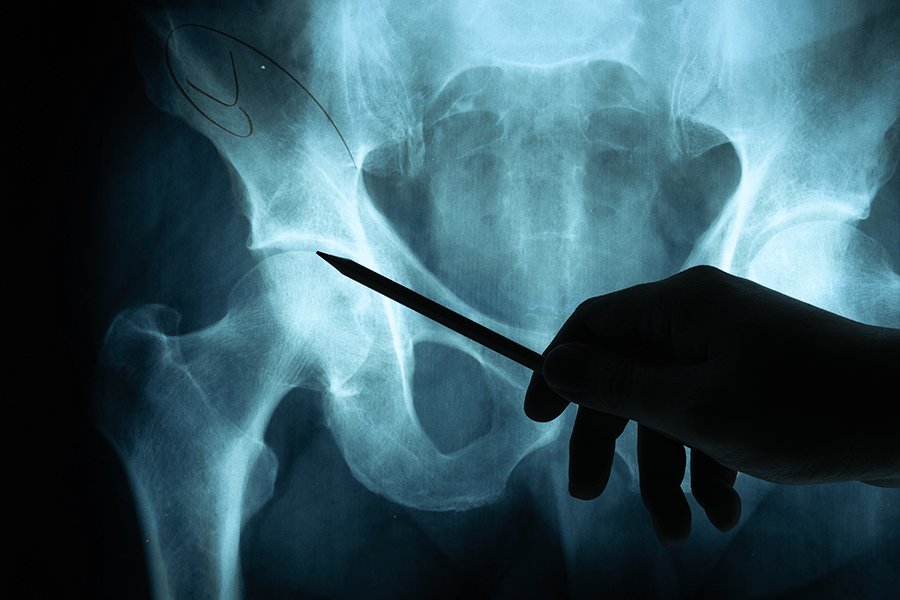- What is an anterior approach hip replacement?
- Why would I need a hip replacement?
- What’s recovery like after an anterior approach hip replacement?
Hip replacement surgery, which is also called total hip arthroplasty, is performed by a qualified orthopedic surgeon in a hospital or outpatient facility. Surgeons can conduct the surgery from the side (lateral), the back (posterior), or the front (anterior).
Bill S. had an anterior total hip replacement with Travis Clegg, M.D., a board-certified orthopedic surgeon specializing in minimally invasive hip and knee replacement. Bill says, “The biggest benefit of having a total hip replacement with Dr. Clegg, is I’ve literally just gotten my life back.”
What is an Anterior Approach Hip Replacement?
Hip replacement is a surgical procedure to remove your hip joint and replace it with an artificial joint. An anterior approach hip replacement is a minimally invasive procedure that spares the muscles and ligaments around the hip joint from damage while conducting the surgery.
 Benefits of an anterior total hip replacement surgery include:
Benefits of an anterior total hip replacement surgery include:
- Faster recovery
- Shorter hospital stay
- Fewer restrictions following surgery
- Reduced risk of dislocation
- Smaller incision scar (typically 4-5 inches vs. 8-9 inches with the posterior approach)
- No “hip limp” because an anterior approach does not affect the buttocks muscles
Your hip joint consists of a ball and socket. The ball is made up of the end of the thigh bone (femur), which has a rounded shape called the femoral head that fits into a socket in your pelvis. This pelvic cup or socket is called the acetabulum. There is a tough protective cartilage that coats the inside of the acetabulum and the femoral head so the ball and socket can rotate and glide easily together so you can walk, run or conduct other normal daily activities. The tissues that line the joint produce a little lubrication to ease the process, while strong connective fibers called ligaments and muscles hold everything together.
During an anterior approach hip replacement, Dr. Clegg will go through the front of the hip to reach the joint. Since there are fewer muscles in the front of the hip, Dr. Clegg won’t have to cut through and damage muscle, which is what happens during a posterior (rear) hip replacement surgery. The anterior approach also requires a smaller incision of about five inches. In other types of hip replacement the incision is double that size.
Once Dr. Clegg can see the hip joint, the goal is to replace the acetabulum and femoral head with an artificial joint. Dr. Clegg will clean up the cartilage and may take an x-ray to be sure the joint is secure and in the right place. The incision is closed and the patient gradually wakes up from surgery under the watchful eye of the medical team.
Typically, an anterior approach hip replacement can be performed in an outpatient facility in just one hour and the patient can go home to recuperate the same day.
Why Would I Need a Hip Replacement?
When the hip is damaged or when wear and tear on the joint causes it to malfunction, Dr. Clegg may consider recommending a hip replacement.
Trauma, such as falling and fracturing a hip or being in a car accident, could require that the hip joint be replaced. However, many times, hip replacement is caused by long-term wear and tear of the ball and socket. Simply put, over the years, your joints can just wear out.
 Some common reasons for having hip replacement include:
Some common reasons for having hip replacement include:
- Bone fracture
- Bone tumors
- Injury
- Osteoarthritis
- Rheumatoid arthritis
The chief symptom that indicates you need hip replacement is pain. Hip or groin pain when walking or sitting can be severe. Bill says, “There was no cartilage. It was bone on bone literally grinding with every step. It was terrible.”
People with a “bad hip” can miss out on more than strenuous exercise; they can have trouble even walking or doing other everyday tasks.
Bill says, “I was literally and figuratively grinding down. Everything had become a chore. I wasn’t able to do the normal things in life. I’ve got a honey-do list seven miles long!”
You may be too stiff to bend down to put on your shoes. The hip may pop or grind and the pain can be intense. You may need pain medications just to get around. Eventually, when other therapies such as non-steroidal anti-inflammatories, exercise, or walking aids no longer work, it may be time for hip replacement surgery.
After his hip replacement, Bill says, ““I’m shocked at what the level of improvement was. My wife is ecstatic.” Bill is now back to his normal routine – including completing all the tasks on his wife’s to-do list.
Dr. Clegg says that Bill had an exceptionally easy outpatient surgery, “He was in and out of the hospital in just a couple of hours and has done remarkably well.” Today, Dr. Clegg says, “He’s completely pain free and has a great range of motion. He’s able to do pretty much everything he wants to do.”
What’s Recovery Like After an Anterior Approach Hip Replacement?
 The benefit of anterior approach hip replacement is an easier recovery period, especially when compared to the other types of surgical options available today. For example, a posterior approach hip replacement can take up to four months recovery time. The anterior approach takes two to eight weeks. In both procedures, Dr. Clegg will work with a physical therapist to exercise the leg and put you back on your feet as quickly as possible. No matter the approach, hip replacement has one of the highest success rates of any joint replacement procedure.
The benefit of anterior approach hip replacement is an easier recovery period, especially when compared to the other types of surgical options available today. For example, a posterior approach hip replacement can take up to four months recovery time. The anterior approach takes two to eight weeks. In both procedures, Dr. Clegg will work with a physical therapist to exercise the leg and put you back on your feet as quickly as possible. No matter the approach, hip replacement has one of the highest success rates of any joint replacement procedure.
During this time, you will work closely with Dr. Clegg. Bill says, “The follow up was great. Everybody in his office has been wonderful.”
Bill was very pleased with the relationship he built with Dr. Clegg as his orthopedic provider. He says, “I usually don’t see that person-to-person connection with physicians. They’ve got X number of minutes, they come in and they leave. But he genuinely cared about me.”
He says, “I absolutely would recommend Dr. Clegg to anyone.”
If you’re experiencing hip pain, you have options. Call us at 1-812-945-5633 and start living pain free again.
